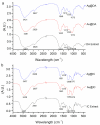Evaluation of the Antioxidant Capacities of Antarctic Macroalgae and Their Use for Nanoparticles Production
- PMID: 33672102
- PMCID: PMC7926919
- DOI: 10.3390/molecules26041182
Evaluation of the Antioxidant Capacities of Antarctic Macroalgae and Their Use for Nanoparticles Production
Abstract
Macroalgae are sources of bioactive compounds that are interesting from both a chemical and a medical point of view. Although their use in biomedicine has increased significantly in recent years, tests conducted to date have been mostly related to species from temperate latitudes, with the potential application of Antarctic biodiversity being minor. The wide variety of algae species present on Antarctic coastal areas can be a source of new antioxidants. Bearing this in mind, the brown macroalgae Desmarestia antarctica (DA) and the red Iridaea cordata (IC) were selected for the preparation of aqueous extracts with the aim of analyzing their antioxidant activity. This analysis was performed by determining reducing power, total phenolic content, and 2,2-diphenyl-1-picrylhydrazyl free radical scavenging activity. Furthermore, both extracts were employed to synthesize gold and silver nanoparticles. The nanomaterials were fully characterized by means of UV-Visible spectroscopy, transmission electron microscopy, Z potential measurements, and Fourier transform infrared spectroscopy, which confirmed the formation of stable, spherical nanoparticles with mean diameters of 13.7 ± 3.1 and 17.5 ± 3.7 nm for Ag@DA and Ag@IC and 12.6 ± 1.9 and 12.3 ± 1.6 nm for Au@DA and Au@IC. Antioxidant assays were performed after the synthesis of the nanomaterials to evaluate their possible synergistic effect with the extracts. The results suggest that polysaccharides and proteins may play a key role in the process of reduction and stabilization. Finally, for the sake of comparison, the results obtained for the Antarctic macroalgae Desmarestia menziesii and Palmaria decipiens have also been considered in the present work.
Keywords: DPPH scavenging activity; Desmarestia antarctica; Iridaea cordata; gold nanoparticles; green synthesis; reducing power; silver nanoparticles; total phenolic content.
Conflict of interest statement
The authors declare no conflict of interest.
Figures





Similar articles
-
Biogenic Silver and Zero-Valent Iron Nanoparticles by Feijoa: Biosynthesis, Characterization, Cytotoxic, Antibacterial and Antioxidant Activities.Anticancer Agents Med Chem. 2020;20(14):1673-1687. doi: 10.2174/1871520620666200619165910. Anticancer Agents Med Chem. 2020. PMID: 32560617
-
Bioactivity and composition of lipophilic metabolites extracted from Antarctic macroalgae.Braz J Microbiol. 2021 Sep;52(3):1275-1285. doi: 10.1007/s42770-021-00475-6. Epub 2021 Apr 9. Braz J Microbiol. 2021. PMID: 33835420 Free PMC article.
-
Green Synthesis of Gold and Silver Nanoparticles Using Leaf Extract of Clerodendrum inerme; Characterization, Antimicrobial, and Antioxidant Activities.Biomolecules. 2020 May 29;10(6):835. doi: 10.3390/biom10060835. Biomolecules. 2020. PMID: 32486004 Free PMC article.
-
Algae Polysaccharides' Chemical Characterization and their Role in the Inflammatory Process.Curr Med Chem. 2017;24(2):149-175. doi: 10.2174/0929867323666161028160416. Curr Med Chem. 2017. PMID: 27804878 Review.
-
It comes from the sea: macroalgae-derived bioactive compounds with anti-cancer potential.Crit Rev Biotechnol. 2024 May;44(3):462-476. doi: 10.1080/07388551.2023.2174068. Epub 2023 Feb 26. Crit Rev Biotechnol. 2024. PMID: 36842998 Review.
Cited by
-
Immunomodulatory and Antitumoral Activity of Gold Nanoparticles Synthesized by Red Algae Aqueous Extracts.Mar Drugs. 2022 Feb 28;20(3):182. doi: 10.3390/md20030182. Mar Drugs. 2022. PMID: 35323481 Free PMC article.
-
Antimicrobial and anti-biofilm activity of silver nanoparticles biosynthesized with Cystoseira algae extracts.J Biol Inorg Chem. 2023 Jun;28(4):439-450. doi: 10.1007/s00775-023-01999-y. Epub 2023 Apr 21. J Biol Inorg Chem. 2023. PMID: 37083842 Free PMC article.
-
Structural characterization, antioxidant and anti-uropathogenic potential of biogenic silver nanoparticles using brown seaweed Turbinaria ornata.Front Microbiol. 2023 Sep 1;14:1072043. doi: 10.3389/fmicb.2023.1072043. eCollection 2023. Front Microbiol. 2023. PMID: 37727290 Free PMC article.
-
Brown Macroalgae Sargassum cristaefolium Extract Inhibits Melanin Production and Cellular Oxygen Stress in B16F10 Melanoma Cells.Molecules. 2022 Dec 5;27(23):8585. doi: 10.3390/molecules27238585. Molecules. 2022. PMID: 36500679 Free PMC article.
-
Valorisation of the Invasive Macroalgae Undaria pinnatifida (Harvey) Suringar for the Green Synthesis of Gold and Silver Nanoparticles with Antimicrobial and Antioxidant Potential.Mar Drugs. 2023 Jul 9;21(7):397. doi: 10.3390/md21070397. Mar Drugs. 2023. PMID: 37504928 Free PMC article.
References
-
- Wulff A., Iken K., Quartino M.L., Al-Handal A., Wiencke C., Clayton M.N. Biodiversity, biogeography and zonation of marine benthic micro-and macroalgae in the Arctic and Antarctic. Bot. Mar. 2009;52:491–509. doi: 10.1515/BOT.2009.072. - DOI
-
- Clarke A., Crame J.A. The origin of the Southern Ocean marine fauna. Geol. Soc. Lond. Spéc. Publ. 1989;47:253–268. doi: 10.1144/GSL.SP.1989.047.01.19. - DOI
-
- Quartino M.L., Boraso de Zaixo A.L. Summer Macroalgal Biomass in Potter Cove, South Shetland Islands, Antarctica: Its Production and Flux to the Ecosystem. Polar Biol. 2008;31:281–294. doi: 10.1007/s00300-007-0356-1. - DOI
MeSH terms
Substances
Grants and funding
LinkOut - more resources
Full Text Sources
Other Literature Sources
Medical

